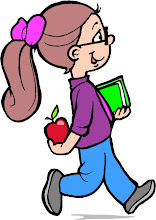When I decided to go ahead and start teaching K. to read, I figured I could probably find everything I needed for free on the internet. The problem I ran into was that there was too much information, and I became frustrated. My goal here is to give you a simple sequence in which to present phonics instruction, keeping workpages to a minimum.
Step 1 was to teach the
sounds of the letters. If this is the method you are using, you should either choose only pictures of items that have the same sound (cat, church, and ceiling all start with c, but they don't sound the same) or have a different folder for each sound of that letter.
Step 2 was to start sounding out
three letter words using the short vowel sounds. Originally I made the lists, but I've decided that a better way to go is to write each letter of the alphabet on a 3 x 5 card and use them to "build" words. I wrote a five page book with sentences for her to read and some for me to read. This allows the story to have more complete thoughts without having to introduce words K. hasn't learned to read yet. The book has colorful pictures I pulled from clip art to make it fun and interesting.
Step 3 is to introduce the consonant blends: br, cr, tr, fr, dr, gr, pr, bl, pl, cl, fl, st, sn, sm, and str. I'm using the 3 x 5 cards to build words. Because K. sometimes wants to do "homework" (the influence of college aged siblings), I've made three workpages for her to do, matching the blends to pictures of items that begin with that blend. After we've practiced the blends well enough, there will be another "book" for her to read.




